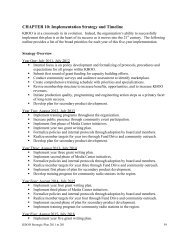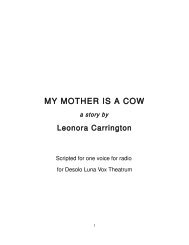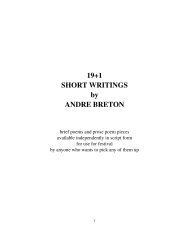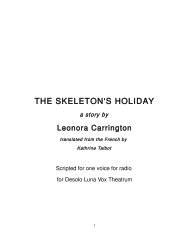NOTES for NOTEBOOK OF A RETURN TO A NATIVE LAND.pdf
NOTES for NOTEBOOK OF A RETURN TO A NATIVE LAND.pdf
NOTES for NOTEBOOK OF A RETURN TO A NATIVE LAND.pdf
- No tags were found...
Create successful ePaper yourself
Turn your PDF publications into a flip-book with our unique Google optimized e-Paper software.
[Page 16]: mentula: "penis" (Latin), based on an Indo-European stem designating a stickagitated to produce fire.[Page 16]: jiculi: according to Cesaire, a variation on the word "jiquilite," a kind of indigotree planted in El Salvador in the 19th century. The word could also be a variation on"jique," a Cuban timber tree. Whatever it is, in the poem it suggests that its ingestionproduces a hallucinatory effect.[Page 18]: a little ellipsoidal nothing trembling four fingers above the line: probably refers toMartinique, which is oval shaped and close to the equator.[Page 19]: Haiti where negritude rose <strong>for</strong> the first time: The Haitian slave revolt, led byToussaint Louverture (1743-1803), brought about the independence of Haiti in 1804.Although Cesaire was by no means the sole exponent of negritude, the word is nowinseparable from his name, and partially responsible <strong>for</strong> his prominent position in the ThirdWorld. Coined with his friends Leon-Gontran Damas and Leopold Senghor while editingtheir newspaper, L'Etudiant noir (The Black Student), in Paris in the mid-1930s, the wordfirst appeared in poetry in the Notebook. A neologism, it is made up (perhaps on the modelof the South American negrismo) by latinizing the derogatory word <strong>for</strong> a black ("negre") andadding a suffix <strong>for</strong> abstract nouns (latitude, solitude, exactitude, etc.). It signified aresponse to the centuries-old problem of the alienated position of the blacks in history, andimplicitly called upon blacks to reject assimilation and cultivate consciousness of their ownracial qualities and heritage. For Cesaire, identity in suffering, not genetic material,determined the bond among black people of different origins.To consider negritude also brings up the problems in translating the word "negre"when it occurs in Notebook. Put briefly, the lexical background is as follows: Be<strong>for</strong>e theSecond World War the French had three words to designate individuals or things belongingto the black race. The most euphemistic was "noir" (noun or adjective). The derogatorywas "negro." In between, on a sort of neutral and objective ground, was the word "negre,"used both as a noun or as an adjective (as in "l'art negre"). For the general public, "noir"and "negre" may very well have been interchangeable, but the very civilized and verycomplexed Antilleans considered themselves as "Noirs," the "negres" being on that distantcontinent, Africa. And it is in this light that one must read Cesaire's use of the word "negre"3
[Page 33]: Amazons ... Madhis: Amazons in this context refers to female warriors in theancient African kingdom of Dahomey. Ghana is the medieval West African empire afterwhich the modern nation is named. Timbuktu was an outstanding educational center of theMiddle Ages. Askia the Great was ruler of Songhai (a 15th-century Malian empire). Djenne,in present-day Mali, was a university and trade center in the Middle Ages. Madhis are Islamleaders of a holy war.[Page 33]: chicote: a Portuguese knotted leather slave whip.[Page 34]: the Calabars: a people from southeastern Nigeria. The city of Calabar was aslave depot.[Page 34]: Nothing could ever lift us ... the shape of their pelvis: The stanza is a mishmashof physiological arguments used to describe the inferiority of the black race, notably by theFrench writer Arthur de Gobineau, whose theories are alluded to here. A craniometer is aninstrument <strong>for</strong> measuring skull size, once thought to be a factor in the brain's evolution."Homo sum" means "I am man," from the Latin of the Roman playwright Terrence (who as aboy was the slave of a Roman senator who educated him and gave him his freedom).[Page 36]: COMICAL AND UGLY: Cesaire's phrase appears to allude to CharlesBaudelaire's poem "The Albatross," where it occurs. There an albatross, once "prince of theclouds," is trapped by sailors and <strong>for</strong>ced to drag its great wings about on deck.[Page 36]: menfenil: According to Jourdain, the menfenil (also known as the malfini) is theFalco sparverious caribaerum, or the Caribbean sparrow haws ("funereal" here not onlybecause of the mood of the poem at this point but also because of the bird's blackplumage).[Page 38]: chalaza: a whip made of hard fibers.[Page 38]: postillion: a household servant dressed in fine clothes whose task was towelcome the newly arrived captives and give them the impression that slaves were well6
treated.[Page 41]: Eia <strong>for</strong> the royal Cailcedra: "Eia" is a triumphant cry; the cailcedra (a Wolofword) is the African mahogany.[Page 43]: to gird one's loins like a brave man: an echo of God's words to Job: "Gird upnow thy loins like a man" (Job 38:3).[Page 44]: wounds cut in its trunk: probably a reference to the rubber tree, which thrives onincisions made in its trunk to produce sap.[Page 46]: oh those queens ... chestnut trees: probably refers to Cesaire's memories of theLuxembourg Garden, in Paris's Latin Quarter, with its many statues of queens underchestnut trees.[Page 46]: the twenty-nine legal blows of the whip: the limit prescribed by the 1865 CodeNoir (Black Code) designed to regulate slave owner's treatment of their slaves. In this line,and in the twenty that follow, Cesaire lists the tortures, the names of some slave holderswho carried them out, and the torture devices. All of this material is documented in thewritings of Victor Schoelcher (the French legislator who was most responsible <strong>for</strong> pushingthe abolition laws through parliament in 1848) and are reprinted in Esclavage etColonisation (Presses Universitaires de France, Paris, 1948), a collection of Schoelcher'stexts, to which Cesaire contributed a Preface. See in particular the chapter "La conditionservile."[Page 46]: the fleur de lys: The fleur de lys, or lily flower, is the emblem of the FrenchBourbon Dynasty, with which recaptured slaves were branded.[Page 46]: Mayencourt: a slave holder who caused the death of one slave by keeping himin a dog house <strong>for</strong> six months.[Page 50]: the penetrance of an apocalyptic wasp: perhaps an allusion to the plague that7












